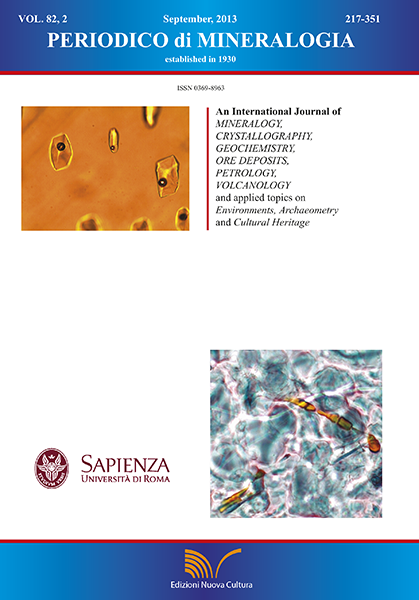REY and Sr-Nd isotopic ratios of aqua regia extracts to assess pedogenic processes and pollution in soils from Ravenna (north Italy)
DOI:
https://doi.org/10.2451/2013PM0020Keywords:
Sr-Nd isotopes, REY, Ca and Sr, soils, plant tissues, aqua regia extracts, REY-Sr sources, Ravenna, ItalyAbstract
Sr, Ca and REY (REE+Y) concentrations along with Sr-Nd isotopic ratios have been determined in 17 aqua regia extracts from three soils of different land use, located in the area near the industrial town of Ravenna, in northern Italy, to test what information can be obtained about the pedogenesis, Sr and REY provenance and soil pollution. 6 samples of selected parts of horticultural plants from the agricultural soil, have also been analyzed for Sr isotopic composition. The Sr and Ca concentrations in the extracts generally increase with depth in each soil profile, reflecting selective mineral weathering in upper horizons and removal of the two elements by the soil solution. In this context, the decrease of the Sr/Ca ratios with depth in each profile suggests preferential removal of Ca, due to resistance of non-carbonate Sr-bearing minerals to weathering and preferential Ca uptake by plants as a nutrient. The PAAS-normalized REY patterns of the extracts from two out of the three studied soils, are similar, displaying middle REE enrichment with a Gd peak and, generally, a positive Y anomaly. These characteristics suggest the contribution of marine carbonates and phosphates. The aqua regia extracts of the two soils perturbated by plowing and gardening practices, exhibit narrower ranges of δ87 Sr (from -0.49 to -0.97) than the natural soil (from -1.03 to +0.37). However, excluding decarbonated upper horizons, the natural soil displays a δ87 Sr range (from -0.47 to -1.03) similar to the other two soils. These overlapping ranges indicate that labile Sr mainly derives from a common source, represented by marine carbonates and phosphates of the bedrocks. In the geological context of the study area, Miocene sedimentary formations of Romagna’s Apennines may be the likely sources of those phases. In contrast, the more positive δ87 Sr (from -0.21 to +0.37) of decarbonated upper horizons of the natural soil, likely reflect the contribution of radiogenic Sr from silicates of old crustal rocks from either the bedrock and/or atmospheric deposition (Saharan dust). The three soils display overlapping and relatively narrow ranges of εNd (from -6.5 to -9.4), indicating a common source of Nd, mainly represented by phosphates. The contribution from silicates of old crustal rocks appears to be very subordinate. The Sr-Nd isotopic overlap of the soil extracts with the corresponding ranges of anthropogenic (i.e. industry, traffic) sources, prevents from ascertaining potential pollution from the study area. Compared with the isotopic values of the soil extracts, the higher δ87 Sr (from -0.32 to -0.07) of selected parts of horticultural plants grown on the agricultural soil, indicate the soil solution from which the plants uptake Sr, contains more radiogenic Sr. The comparison with the δ87 Sr of the ammonium acetate extracts from the same soil samples, indicates that the milder extraction than that carried out with aqua regia, leaves non-radiogenic Sr-bearing phosphates undissolved and, thus, more radiogenic Sr in the solution. As a whole, the aqua regia extraction of soil samples can provide significant information on the behavior of Sr and REY in the pedogenesis as well as in recognizing the sources of these elements with respect to the soluble soil phases and their possible references in the geological context of the study area. In contrast, the aqua regia extraction is not a suitable procedure for studying the soil-plant relationship, providing less information than the ammonium acetate extraction.


